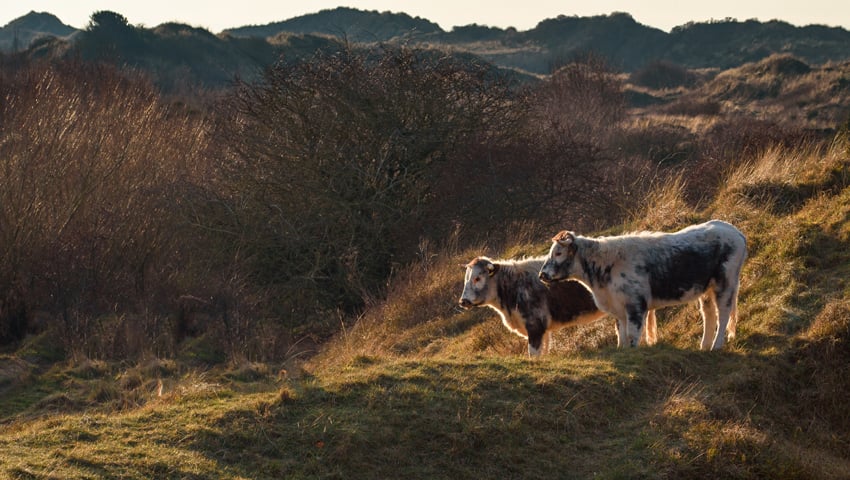Article by Patrick Holden, Chief Executive of the Sustainable Food Trust
The Sustainable Food Trust has just published what I believe to be an important, even historic report, on the potential role of grazing livestock in our future farming and food systems.
While we made a concerted effort to generate the level of media attention we believe this report merits, coverage was more limited than we’d hoped.
We did secure some important pieces, including a column by George Monbiot in The Guardian – albeit a characteristically critical one – along with articles in Forbes, Farmers Guardian, Farming Online, 8point9 and others.
However, numerous outlets declined to cover the story, and even Farming Today, which we thought might recognise this report’s strategic significance, chose to focus instead on an interview with Labour MP Toby Perkins, who argued for separation between productive land for food growing and areas for nature.
Sadly, this epitomises the current attitude of the government, NFU, media, policy makers and scientists and even many of the NGO community, most of whom are in favour of a land sparing rather than a land sharing approach.
In summary, this means separating food production from nature, despite the fact that if we go down this road and use intensive methods for food production there will be no coexistence with biodiversity, nor will it be possible to produce nutrient dense food free of pesticide residues.
Why do I think that our report is so important? Because it seems to me that the only way that we can reverse the devastating negative impacts of a century of intensive extractive farming on climate, nature and society is to switch to biologically based systems. In doing so, we can rebuild and retain the soil carbon and in-field biodiversity stocks, which we have lost, through the wide-scale adoption of crop rotations that include a fertility building phase, which, as we explained in our previous report, ‘Feeding Britain From the Ground Up’, will often occupy 50 per cent of the rotation.
Without such crop rotations we will not be able to wean ourselves off the current addiction to chemical fertilisers and pesticides, rebuild soil carbon or restore the field habitat to what it used to be, namely a system in which food production can coexist with nature and produce nutrient-dense food to nourish future generations.
This holistic perspective is almost entirely absent from the current public discourse about future land use, food security, improving public health, addressing climate change, restoring biodiversity, I could go on!
It is clearly of vital importance to understand why there is such a lack of enthusiasm to adopt this approach. Part of this reluctance relates to our attitude to livestock. The last decade has witnessed a growing prejudice against ruminant animals, mainly because of accusation that, in terms of greenhouse gas emissions from methane, they are part of the problem. In parallel with this, there is another factor, namely demonisation of animal fats, since the publication of the COMA report back in the 1980s, which fundamentally shifted the British diet from the consumption of animal-based to plant-based fats.
As we explain in the report, not only has the methane contribution made by ruminant animals often been exaggerated (because of a commonly used but overly simplistic calculation, which Professor Myles Allen of Oxford University, and others, have now challenged), but also because the way in which the emissions of cattle are calculated has not been linked to the positive carbon sequestration from the pasture lands to which they should be umbilically linked.
This is important, because the only way to turn the 50 per cent fertility building phase of biologically based crop rotations into food that we can eat is via grazing animals: sheep and beef and dairy cows.
These animals alone can convert human indigestible forage into foods that have the potential to comprise a significant proportion of our daily nutrient needs. More than that, and of equal importance, such systems when applied on a national scale could play a very significant role in rebuilding the soil carbon stocks as more and more farmers are now finding through their adoption of holistic, regenerative, adaptive multi-paddock, mob grazing systems – choose your term!
This has been my personal experience on our 300-acre mixed organic dairy farm in Wales. Since we switched to more disciplined, rotational grazing we are producing more forage from that land, plus (we are almost certain from the data we have) this is mirrored below the ground in increased soil carbon stocks.
It’s easy if you are a practitioner to appreciate the potential of scaling such systems, especially, as in our case, we have had the privilege of witnessing the longer-term impact of biologically based farming over a span of 50 years.
However, what we are faced with is the substantial disconnect between the mainly urban based media, policy makers and even NGO employees all of whom have had, through no fault of their own, little exposure to the kind of farming systems that I believe could go to scale in the UK and indeed throughout the world.
George Monbiot’s article perhaps did us a backhanded favour by at least drawing attention to our report, albeit through a highly critical lens. While we disagree with many of his points – particularly the selective use of science and the emotionally charged framing – it has helped prompt important public debate.
‘Grazing Livestock: It’s not the cow but the how’ was published by the Sustainable Food Trust on 7th May 2025.
